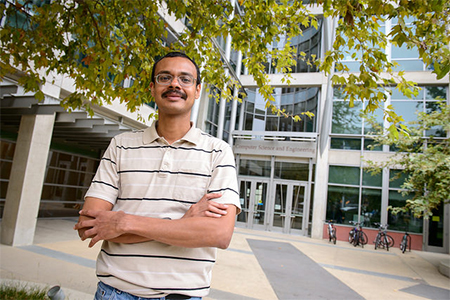
UC San Diego Computer Science Professor Reaches Finals of Inaugural Online Teaching Prize
Professor Ravi Ramamoorthi cited for pioneering work on computer graphics education
Published Date
By:
- Doug Ramsey
Share This:
Article Content

UC San Diego professor Ravi Ramamoorthi is among the pioneers of massive open online courses on the edX platform.
One of the largest online course platforms, edX, announced the finalists for its inaugural edX Prize for Exceptional Contributions in Online Teaching and Learning. The 11 finalists for the first edX Prize in 2016, announced this week, include University of California San Diego professor Ravi Ramamoorthi, who was also recently appointed to the Ronald L. Graham Chair of Computer Science. A professor in the Computer Science and Engineering (CSE) department of the university’s Jacobs School of Engineering, Ramamoorthi and other nominees worldwide were selected because they were very influential in the early development of online teaching and learning methodologies and courses, and had taught highly successful courses on the edX platform in the last two years. The finalists will be evaluated further by the edX University Advisory Board, which will select a winner later this summer. The winner and finalists will all be recognized at edX’s 2016 Global Forum in the Sorbonne in Paris this November.
“In its first year, the edX Prize jury recognized as finalists some of the top early pioneers of massive open online courses – so-called MOOCs,” said edX Director of Academics and Research, Nina B. Huntemann, adding that the committee included faculty, instructional designers, college deans, and online learning directors from edX partner institutions.
On multiple counts, Ramamoorthi can claim to be one of the earliest practitioners of online teaching. “Professor Ramamoorthi is a true pioneer in online education, teaching the first-ever MOOC in computer graphics, which he did at UC Berkeley, and the course was one of the first nine courses launched on the edX platform in fall 2012,” said Jeff Elman, director of the Office for Online and Technology Enhanced Education at UC San Diego. “That course featured the first automatic grader for graphics assignments, based on thresholded image differences, an innovation that was essential for the visual concepts in computer graphics. It was a radical departure from prior text or multiple-choice grading schemes.”
Elman, who nominated Ramamoorthi for the edX Prize, also noted that when he joined the UC San Diego faculty in 2014, the computer scientist developed CSE 167x, Computer Graphics, to be the first course launched under the university’s new partnership with edX.
In the period of eligibility to be considered for the edX Prize, Ramamoorthi’s graphics courses were taught three times. In late 2014, students were able to take his BerkeleyX course. Subsequently, Ramamoorthi taught UC San Diego’s first edX course, 167x, at the instructor’s pace, and a few months later the same course opened for new enrollment offering students course material they could take at their own pace.
“Across half a dozen instalments of my online courses, more than 100,000 learners have registered to take the courses through edX,” said Ramamoorthi, who also directs the Center for Visual Computing at UC San Diego. “We also offer the video lectures from the course through YouTube, and at last check, students and instructors had viewed the YouTube videos more than 500,000 times.” These numbers speak to the substantial impact Ramamoorthi and edX have had in educating students around the world about computer graphics.
Those numbers do not even include students who registered to take the MOOC in Mandarin translation in fall 2014 through edX’s partner, XuetangX. The Mandarin version is also available to smaller institutions in China, including schools, to run locally as part of a hybrid course, or SPOC (which stands for ‘small private online course’). In a SPOC, instructors combined online modules with classroom teaching in a real (physical) classroom (not just a virtual one).
“Professor Ramamoorthi is clearly a leader in online teaching, not least because he has enabled the visual concepts of computer graphics to be included as an integral part of MOOC education,” added UC San Diego’s Elman. “His original course is an important part of edX history, and its success played a major role in the future growth of the platform. It was also a cornerstone of UC Berkeley’s involvement and integration with edX.”
In June 2015, UC San Diego and edX announced their new partnership. Furthermore, said Elman, “Professor Ramamoorthi's heroic efforts in bringing about the UCSD-edX agreement were a key impetus to setting up UC San Diego’s Office of Online Education, which I now head.”
Many instructors have now included material from Ramamoorthi’s lectures in their local courses, including instructors who teach the regular CSE 167 course in computer graphics at UC San Diego. “My video lectures were adopted for use in UCSD's local 167 classes even prior to my leaving Berkeley to join the UC San Diego faculty,” added Ramamoorthi.
In August 2015, the independent MOOC reviewer, Class Central, which compiles information and feedback about online courses from all of the largest MOOC providers, including edX and Coursera, selected UC San Diego’s CSE 167x computer graphics course as one of its top three ‘spotlight’ courses based on quality and feedback from learners.
Share This:
You May Also Like
Stay in the Know
Keep up with all the latest from UC San Diego. Subscribe to the newsletter today.


